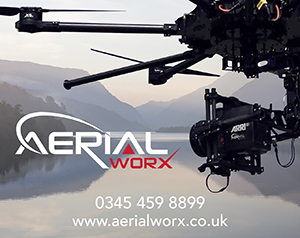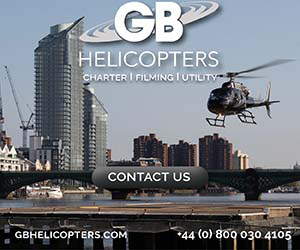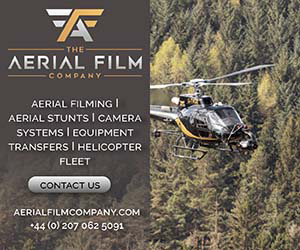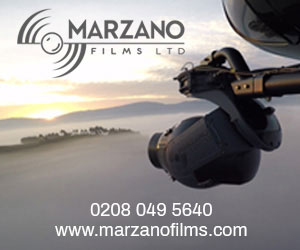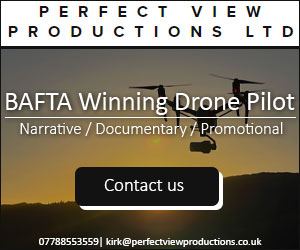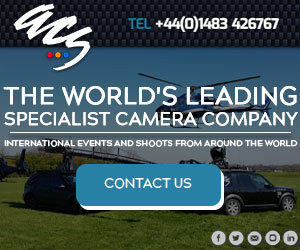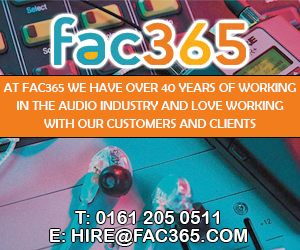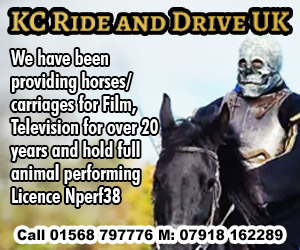Broadcast News
22/01/2016
Lights, Camera, Take Off...

While your first consideration should always be the skill and experience of the pilot and remote camera operator, your second should be the suitability of the drone. Surprisingly, our clients rarely ask us about this.
However, just as there are a multitude of options for cameras, each delivering their own look to your production, there's also an ever expanding choice of aerial camera platforms, some more suited to one production than another. Make the right choice and your production values will soar. Get it wrong and you might not get the shot you want or be left fixing the footage in post.
To choose the right drone for your production here's a quick, albeit far from comprehensive, guide to the most common drones you're likely to encounter and what they are best suited to in our experience.
DJI Phantom 3
The Phantom 3 has three versions – Standard, Advanced and Professional – the main difference being the built-in cameras. Standard and Advanced is limited to Full HD (1080p) whereas the Professional is capable of 4K video at 24/25fps or 1080p at 48/50fps. Despite the small 1/2.3 inch sensor the Phantom f/2.8 lens avoids most of the fish-eye distortion you find with other action cameras. It also uses an indoor vision positioning sensor making it ideal for rock steady indoor shoots. The Phantom's main shortcoming is stability in high winds and that camera motion is limited to tilt (pan must be adjusted by aircraft yaw) controllable only by the pilot. Even so, it's the ideal choice for cash-strapped productions.
• Ideal for: Daytime TV, news, sports, and documentaries
• Max flight time: 25 min
• Expect to pay: £400 – £700 a day
DJI Inspire 1
Since its release, the Inspire 1, with its X3 camera shooting 4K up to 60fps, has become a favourite for TV and drama. With the recent addition of the mounted X5R micro-4/3 4K camera supporting interchangeable lenses, and even raw recording, we expect this trend to accelerate in 2016. Despite its small size, it's rock solid in wind, and the 3-axis gimbal delivers perfectly stabilized footage and full 360-degree motion. The best news is the camera can be controlled by a separate camera operator making it possible to give your production that big budget look. In addition, a built-in digital transmitter delivers a low latency HD image to the director on the ground. All this in a drone that weights only 2.4 kg and uses batteries small enough to carry on a plane.
• Ideal for: Drama, independent cinema, news, sport and blue-chip documentaries, particularly involving expeditions or transport overseas
• Max flight time: 20 mins
• Expect to pay: £700 – £1,000 a day
DJI S900/S1000
The S1000 octocopter and its smaller sibling, S900 hexacopter, are the first port of call for directors looking for a professional aerial cinematography setup. Around a meter in diameter, these medium-lifters can carry almost any DSLR including the Panasonic GH4, Sony A7S, and Canon 5D. The powerful motors handle windy conditions with ease and the gimbal – controlled by a separate operator – delivers sub-pixel stability and full 360-degree rotation. If you need a director's monitor it is worth checking the pilot has one and if it uses a digital or analog signal since the latter can suffer from interference. The extra weight does mean flight times are shorter but still long enough to film most aerial scenes. Also, safety is a greater consideration and so are best used in controlled areas away from the public.
• Ideal for: Drama, independent cinema and blue-chip documentaries
• Max flight time: 10 – 15 mins
• Expect to pay: £1,000 – £1,500 a day
FreeFly Cinestar 8
The Cinestar 8 was one of the first professional heavy-lifter drones used in TV and film and can still be found flying the Red Epic and similar weight cinema cameras. Normally it flies with a Movi gimbal, and so can support individual control of both camera motion and focus/iris by ground crew. While it's a truly robust and powerful drone, its drawbacks are mobility, particularly since it doesn't easily fold-down for transport like many newer models tend to do. Also, they are usually built and maintained by the pilot so capabilities and quality can vary depending on who you hire. A good option when a DSLR just wont cut it.
• Ideal for: Drama, cinema and blue-chip documentaries
• Max flight time: 8 – 15 mins
• Expect to pay: £1,200 – £1,600 a day
FreeFly Alta
The Alta hexacopter is fast becoming the definitive aerial platform for lighter cinema cameras like the carbon RED and ARRI Mini. It has several really nice features including being able to mount the camera on top as well as underneath, the ability to fly in rain, and a foldable frame for easy transport. It also has the advantage of being built by the manufacturer rather than the pilot so you know what you're getting is top-notch. However, it doesn't have the same lifting capacity as a true heavy lift octocopter, so don't expect to fly your camera with iris motor, matte box and anamorphic lens all at the same time.
• Ideal for: Drama, cinema and blue-chip documentaries
• Max flight time: 10 – 15 mins
• Expect to pay: £1,200 – £1,600 a day
Intuitive Aerial Aerigon
The Aerigon is truly the beast of the cinema drone world. With its dozen motors and maximum payload capacity of over 13kg it was designed specifically for high-end professional productions with a budget to match. Given its size, the Swedish engineers behind it wisely made it easy to dismantle and pack away within around five minutes. Still, with each flight needing three batteries, that's a lot of weight to carry around. But if total creative control is what you need and you got the budget nothing else comes close.
• Ideal for: Big budget cinema and blue-chip documentaries
• Max flight time: 8 – 10 mins
• Expect to pay: £3,000+ a day
Image courtesy of Cineflite.
www.cineflite.com
(JP/LM)
However, just as there are a multitude of options for cameras, each delivering their own look to your production, there's also an ever expanding choice of aerial camera platforms, some more suited to one production than another. Make the right choice and your production values will soar. Get it wrong and you might not get the shot you want or be left fixing the footage in post.
To choose the right drone for your production here's a quick, albeit far from comprehensive, guide to the most common drones you're likely to encounter and what they are best suited to in our experience.
DJI Phantom 3
The Phantom 3 has three versions – Standard, Advanced and Professional – the main difference being the built-in cameras. Standard and Advanced is limited to Full HD (1080p) whereas the Professional is capable of 4K video at 24/25fps or 1080p at 48/50fps. Despite the small 1/2.3 inch sensor the Phantom f/2.8 lens avoids most of the fish-eye distortion you find with other action cameras. It also uses an indoor vision positioning sensor making it ideal for rock steady indoor shoots. The Phantom's main shortcoming is stability in high winds and that camera motion is limited to tilt (pan must be adjusted by aircraft yaw) controllable only by the pilot. Even so, it's the ideal choice for cash-strapped productions.
• Ideal for: Daytime TV, news, sports, and documentaries
• Max flight time: 25 min
• Expect to pay: £400 – £700 a day
DJI Inspire 1
Since its release, the Inspire 1, with its X3 camera shooting 4K up to 60fps, has become a favourite for TV and drama. With the recent addition of the mounted X5R micro-4/3 4K camera supporting interchangeable lenses, and even raw recording, we expect this trend to accelerate in 2016. Despite its small size, it's rock solid in wind, and the 3-axis gimbal delivers perfectly stabilized footage and full 360-degree motion. The best news is the camera can be controlled by a separate camera operator making it possible to give your production that big budget look. In addition, a built-in digital transmitter delivers a low latency HD image to the director on the ground. All this in a drone that weights only 2.4 kg and uses batteries small enough to carry on a plane.
• Ideal for: Drama, independent cinema, news, sport and blue-chip documentaries, particularly involving expeditions or transport overseas
• Max flight time: 20 mins
• Expect to pay: £700 – £1,000 a day
DJI S900/S1000
The S1000 octocopter and its smaller sibling, S900 hexacopter, are the first port of call for directors looking for a professional aerial cinematography setup. Around a meter in diameter, these medium-lifters can carry almost any DSLR including the Panasonic GH4, Sony A7S, and Canon 5D. The powerful motors handle windy conditions with ease and the gimbal – controlled by a separate operator – delivers sub-pixel stability and full 360-degree rotation. If you need a director's monitor it is worth checking the pilot has one and if it uses a digital or analog signal since the latter can suffer from interference. The extra weight does mean flight times are shorter but still long enough to film most aerial scenes. Also, safety is a greater consideration and so are best used in controlled areas away from the public.
• Ideal for: Drama, independent cinema and blue-chip documentaries
• Max flight time: 10 – 15 mins
• Expect to pay: £1,000 – £1,500 a day
FreeFly Cinestar 8
The Cinestar 8 was one of the first professional heavy-lifter drones used in TV and film and can still be found flying the Red Epic and similar weight cinema cameras. Normally it flies with a Movi gimbal, and so can support individual control of both camera motion and focus/iris by ground crew. While it's a truly robust and powerful drone, its drawbacks are mobility, particularly since it doesn't easily fold-down for transport like many newer models tend to do. Also, they are usually built and maintained by the pilot so capabilities and quality can vary depending on who you hire. A good option when a DSLR just wont cut it.
• Ideal for: Drama, cinema and blue-chip documentaries
• Max flight time: 8 – 15 mins
• Expect to pay: £1,200 – £1,600 a day
FreeFly Alta
The Alta hexacopter is fast becoming the definitive aerial platform for lighter cinema cameras like the carbon RED and ARRI Mini. It has several really nice features including being able to mount the camera on top as well as underneath, the ability to fly in rain, and a foldable frame for easy transport. It also has the advantage of being built by the manufacturer rather than the pilot so you know what you're getting is top-notch. However, it doesn't have the same lifting capacity as a true heavy lift octocopter, so don't expect to fly your camera with iris motor, matte box and anamorphic lens all at the same time.
• Ideal for: Drama, cinema and blue-chip documentaries
• Max flight time: 10 – 15 mins
• Expect to pay: £1,200 – £1,600 a day
Intuitive Aerial Aerigon
The Aerigon is truly the beast of the cinema drone world. With its dozen motors and maximum payload capacity of over 13kg it was designed specifically for high-end professional productions with a budget to match. Given its size, the Swedish engineers behind it wisely made it easy to dismantle and pack away within around five minutes. Still, with each flight needing three batteries, that's a lot of weight to carry around. But if total creative control is what you need and you got the budget nothing else comes close.
• Ideal for: Big budget cinema and blue-chip documentaries
• Max flight time: 8 – 10 mins
• Expect to pay: £3,000+ a day
Image courtesy of Cineflite.
www.cineflite.com
(JP/LM)
More Aerial Filming Stories
31/01/2023
Flying Features Relies On LiveU
For the third year in a row, the Santos Tour Down Under cycling race was broadcast live from the sky by Australian aerial filming company Flying Featu
Flying Features Relies On LiveU
For the third year in a row, the Santos Tour Down Under cycling race was broadcast live from the sky by Australian aerial filming company Flying Featu
02/06/2017
Live Video Streaming From Drones
Drones provide a mechanism for streaming compelling video that other methods cannot compete with, either from an infrastructure or cost prospective. W
Live Video Streaming From Drones
Drones provide a mechanism for streaming compelling video that other methods cannot compete with, either from an infrastructure or cost prospective. W
26/04/2017
360 Design Announce Flying EYE
360 Designs has announced the launch of Flying EYE, a groundbreaking, 6K, broadcast quality, live streaming VR drone. According to the company the ann
360 Design Announce Flying EYE
360 Designs has announced the launch of Flying EYE, a groundbreaking, 6K, broadcast quality, live streaming VR drone. According to the company the ann
12/04/2017
Festival Recognition For Shetland My Land, My Home
Article contributed by Thomas Haywood, from Thomas Haywood Aerial Photography. Recently, I entered Shetland My Land, My Home into several film festiva
Festival Recognition For Shetland My Land, My Home
Article contributed by Thomas Haywood, from Thomas Haywood Aerial Photography. Recently, I entered Shetland My Land, My Home into several film festiva
31/03/2017
Drone Use In Construction Industry - Part 1
In the first of a two-part report into drones and construction, Jim Meehan, an aerial imaging specialist at SkyHeld Cameras, asks if data quality or s
Drone Use In Construction Industry - Part 1
In the first of a two-part report into drones and construction, Jim Meehan, an aerial imaging specialist at SkyHeld Cameras, asks if data quality or s
31/03/2017
Drone Use In Construction Industry - Part 2
In the second of a two-part report into drones and construction Jim Meehan, aerial imaging specialist at SkyHeld Cameras, rounds up the reasons that d
Drone Use In Construction Industry - Part 2
In the second of a two-part report into drones and construction Jim Meehan, aerial imaging specialist at SkyHeld Cameras, rounds up the reasons that d
30/03/2017
GoPro Karma Now Available In The UK
GoPro have announced that it's complete Karma system is now available at selected online and high street retailers. Karma features a compact design an
GoPro Karma Now Available In The UK
GoPro have announced that it's complete Karma system is now available at selected online and high street retailers. Karma features a compact design an
08/03/2017
Hovercam Goes On The Hunt For Sharks
Hovercam's Benet Allen went shark-baiting with the team from ITV's Fishing Impossible... They told us it was going to be straightforward, if a bit sme
Hovercam Goes On The Hunt For Sharks
Hovercam's Benet Allen went shark-baiting with the team from ITV's Fishing Impossible... They told us it was going to be straightforward, if a bit sme
23/01/2017
Producing Live UHD/4K Aerial Footage On Budget
Just a few years ago, the only option of producing professional, dynamic live aerial footage was renting a turbine driven helicopter equipped with a h
Producing Live UHD/4K Aerial Footage On Budget
Just a few years ago, the only option of producing professional, dynamic live aerial footage was renting a turbine driven helicopter equipped with a h
20/01/2017
BFV's Big Interview: BeyondHD
With 20 years specialising in aerial and vehicle-based stabilised remote head filming equipment and crew hire – from manned aerial filming and class l
BFV's Big Interview: BeyondHD
With 20 years specialising in aerial and vehicle-based stabilised remote head filming equipment and crew hire – from manned aerial filming and class l





